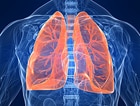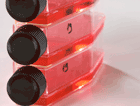AFINITOR is contraindicated in patients with
hypersensitivity to everolimus, to other rapamycin derivatives, or to
any of the excipients.
Noninfectious Pneumonitis:
- Noninfectious pneumonitis was reported in up to 19% of patients treated with AFINITOR. The incidence of Common Terminology Criteria (CTC) grade 3 and 4 noninfectious pneumonitis was up to 4.0% and up to 0.2%, respectively. Fatal outcomes have been observed
- If symptoms are moderate, patients should be managed with dose interruption until symptoms improve
- The use of corticosteroids may be indicated. For grade 4 cases, discontinue AFINITOR. Corticosteroids may be indicated until symptoms resolve
- For grade 3 cases, interrupt AFINITOR until resolution to grade ≤1
- AFINITOR may be reintroduced at a daily dose approximately 50% lower than the dose previously administered, depending on the individual clinical circumstances. If toxicity recurs at grade 3, consider discontinuation of AFINITOR
- The development of pneumonitis has been reported even at a reduced dose
Infections:
- AFINITOR has immunosuppressive properties and may predispose patients to bacterial, fungal, viral, or protozoal infections (including those with opportunistic pathogens). Localized and systemic infections, including pneumonia, mycobacterial infections, other bacterial infections, invasive fungal infections such as aspergillosis or candidiasis, and viral infections, including reactivation of hepatitis B virus, have occurred
- Some of these infections have been severe (eg, leading to respiratory or hepatic failure) or fatal
- Physicians and patients should be aware of the increased risk of infection with AFINITOR
- Treatment of preexisting invasive fungal infections should be completed prior to starting treatment
- Be vigilant for signs and symptoms of infection and institute appropriate treatment promptly; interruption or discontinuation of AFINITOR should be considered
- Discontinue AFINITOR if invasive systemic fungal infection is diagnosed and institute appropriate antifungal treatment
Oral Ulceration:
- Mouth ulcers, stomatitis, and oral mucositis have occurred in patients treated with AFINITOR at an incidence ranging from 44% to 86% across the clinical trial experience. Grade 3/4 stomatitis was reported in 4% to 9% of patients
- In such cases, topical treatments are recommended, but alcohol-, peroxide-, iodine-, or thyme-containing mouthwashes should be avoided
- Antifungal agents should not be used unless fungal infection has been diagnosed
Renal Failure:
- Cases of renal failure (including acute renal failure), some with a fatal outcome, have been observed in patients treated with AFINITOR
Geriatric Patients:
- In the randomized advanced hormone receptor-positive, HER2-negative breast cancer study, the incidence of deaths due to any cause within 28 days of the last AFINITOR dose was 6% in patients ≥65 years of age compared to 2% in patients <65 years of age
- Adverse reactions leading to permanent discontinuation occurred in 33% of patients ≥65 years of age compared with 17% in patients <65 years of age
- Careful monitoring and appropriate dose adjustments for adverse reactions are recommended
Laboratory Tests and Monitoring:
- Elevations of serum creatinine, proteinuria, glucose, lipids, and triglycerides, and reductions of hemoglobin, lymphocytes, neutrophils, and platelets, have been reported
- Renal function (including measurement of blood urea nitrogen, urinary protein, or serum creatinine), blood glucose, lipids, and hematologic parameters should be evaluated prior to treatment and periodically thereafter
- When possible, optimal glucose and lipid control should be achieved before starting a patient on AFINITOR
Drug-Drug Interactions:
- Avoid coadministration with strong CYP3A4 inhibitors (eg, ketoconazole, itraconazole, clarithromycin, atazanavir, nefazodone, saquinavir, telithromycin, ritonavir, indinavir, nelfinavir, voriconazole)
- Use caution and reduce the AFINITOR dose to 2.5 mg daily if coadministration with a moderate CYP3A4 and/or PgP inhibitor is required (eg, amprenavir, fosamprenavir, aprepitant, erythromycin, fluconazole, verapamil, diltiazem)
- Avoid coadministration with strong CYP3A4 inducers (eg, phenytoin, carbamazepine, rifampin, rifabutin, rifapentine, phenobarbital); however, if coadministration is required, increase the AFINITOR dose from 10 mg daily up to 20 mg daily, using 5-mg increments
Hepatic Impairment:
- Exposure of everolimus was increased in patients with hepatic impairment
- For patients with severe hepatic impairment (Child-Pugh class C), AFINITOR may be used at a reduced dose if the desired benefit outweighs the risk. For patients with mild (Child-Pugh class A) or moderate (Child-Pugh class B) hepatic impairment, a dose reduction is recommended
Vaccinations:
- The use of live vaccines and close contact with those who have received live vaccines should be avoided during treatment with AFINITOR
Embryo-Fetal Toxicity:
- Fetal harm can occur if AFINITOR is administered to a pregnant woman. Women of childbearing potential should be advised to use a highly effective method of contraception while using AFINITOR and for up to 8 weeks after ending treatment
Adverse Reactions:
- The most common adverse reactions (incidence ≥30%) were stomatitis (67%), infections (50%), rash (39%), fatigue (36%), diarrhea (33%), and decreased appetite (30%)
- The most common grade 3/4 adverse reactions (incidence ≥2%) were stomatitis (8%), infections (5%), hyperglycemia (5%), fatigue (4%), dyspnea (4%), pneumonitis (4%), and diarrhea (2%)
Laboratory Abnormalities:
- The most common laboratory abnormalities (incidence ≥50%) were hypercholesterolemia (70%), hyperglycemia (69%), increased aspartate transaminase (AST) concentrations (69%), anemia (68%), leukopenia (58%), thrombocytopenia (54%), lymphopenia (54%), increased alanine transaminase (ALT) concentrations (51%), and hypertriglyceridemia (50%)
- The most common grade 3/4 laboratory abnormalities (incidence ≥3%) were lymphopenia (12%), hyperglycemia (9%), anemia (7%), decreased potassium (4%), increased AST (4%), increased ALT (4%), and thrombocytopenia (3%)
You are encouraged to report negative side effects of prescription drugs to the FDA. Visit www.fda.gov/medwatch, or call 1-800-FDA-1088.
Please see full Prescribing Information for AFINITOR.
Reference: 1. AFINITOR [prescribing information]. East Hanover, NJ: Novartis Pharmaceuticals Corp; August 2012.








